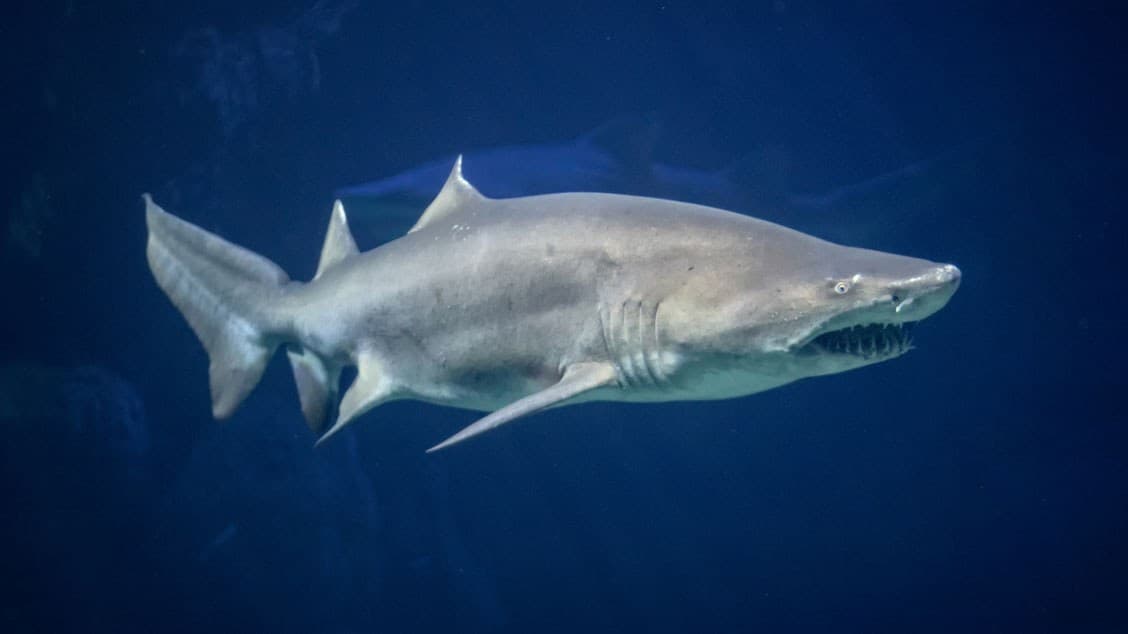Length: Between 6 and 10.5 feet
Weight: Around 200 pounds
Like all sharks, the sand tiger shark is a cartilaginous fish, meaning their skeletal structure is made of cartilage rather than bones. This species has a light brown-to-gray upper body and a short, upturned snout, where three rows of long razor-sharp teeth protrude from the mouth, which never closes. Its body gradually fades to white on its ventral (belly) side and tapers in shape at the tail, which has a notched fin on the underside.
One characteristic that is key to distinguishing the sand tiger shark from others is that its anal and dorsal fins are the same size. Its broad, gray dorsal fins extend beyond the pectoral fins below, and the upper portion of its tail is longer than the lower lobe, which aids swift movement.
Diet
Like many shark species, this shark is an apex (top) predator. Their diet includes bony fish, lobsters, crabs, rays, squid, and smaller shark species. Sand tiger sharks are nocturnal and more active at night, hunting in groups. These hunting groups have been observed working collaboratively to "herd" fish together before attacking from all sides.
Habitat
Sand tiger sharks prefer warm water and thrive in subtropical and temperate oceans, including the Atlantic, Indian, and Pacific oceans. Their range extends from Argentina to the Gulf of Maine in the western Atlantic and out to the east, where they are found off the coast of Europe and in the Mediterranean Sea near North Africa. In the Pacific, sand tiger sharks range from Australia to Japan, and in the Indian Ocean they are found off the coast of South Africa.
Sand tiger sharks prefer surf zones, sandy shallow bays, and rocky coral reefs. They are often found at the bottom of the water column near the floor, and can dive to more than 625 feet. Because of seasonal temperature changes in ocean water, sand tiger sharks migrate during the summer each year.
Reproductive Behavior
The breeding season in the Northern hemisphere is generally from late summer (August) to December, but ends in October in the Southern Hemisphere.
The courtship between a male and female can go on for days after the male has successfully chased away any competing males. Courting consists of them nibbling on each other's caudal (tail) and pectoral fins. When the male senses his partner is ready, they will mate. A female will mate with multiple males in a season.
Around 16-23 embryos will begin to develop in each of the female's two uterine chambers. Within 8 to 12 months, the eggs will begin to hatch internally. However, all but one in each chamber will be cannibalized by the largest and strongest of them, meaning that only 1 or on occasion 2 will survive to a healthy live birth. Sand tiger sharks reproduce only once every 2 or 3 years and have the lowest reproductive rates with high infant mortality rates.
Relationship With Humans
These sharks are not aggressive unless they are provoked or feel threatened. There are accounts of sand tiger sharks stealing fish off fisherman's spears underwater. There have been stories of sand tiger sharks harassing divers, but very few records of unprovoked sand tiger bites on humans, none of which were fatal.
Communication
While sand tiger sharks lack vocal cords and are incapable of making sounds as we do, they are thought to communicate through visual and sensory perceptions. They can detect weak electric fields in water with electroreceptors that help in sensing objects that are nearby. Their later line helps feel vibrations in the water. They also appear to arch their bodies in an attempt to communicate with other sharks.
Buoyancy
Many fish species possess a swim bladder that is generally filled with gases (such as oxygen), and helps them control their buoyancy and position in the water column. Sand tigers are the only shark species that fill their swim bladders with air by swimming to the surface and gulping air down.
Concerns
While population numbers are not concrete, their decline is. Although sand tiger sharks are fished across their wide range, for both commercial and recreational purposes, they are a species with high value in certain regions. They are valued as a food source as well as for medicinal purposes. Overfishing, unsustainable practices, and low birth rates have left this shark vulnerable to population decline.
Celebrations
Even though this shark was historically fished commercially in North America, the implementation of the Atlantic Fishery Management Plan in 1997 gave the species full protection. There are also regulations in place in limited regions around the Mediterranean Sea, eastern Australia, Europe, and the eastern United States.
While considered controversial, some believe that the growth in shark eco-tourism has positively impacted the public impression of sharks and therefore increased support for conservation efforts.


